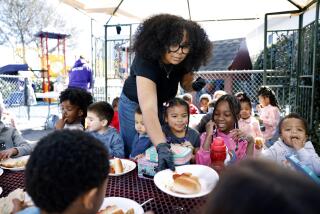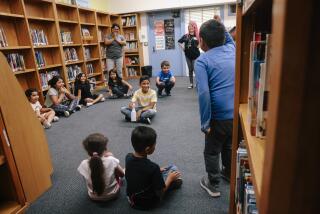More Headaches : Child-Care Dilemma Worsens as L.A. District Extends Year-Round Calendar
It’s bad enough that her son’s school is starting in the middle of August this year, but for Carol Caruso, that is not the worst feature of the Los Angeles Unified School District’s complete switch to the year-round calendar. It is the new, long winter break that is the stuff of her nightmares.
“To me, this summer is feeling very short and I am terrified that this winter is going to feel very long,” said Caruso, a single mother whose 6-year-old, Christopher Rapaport, attends Carpenter Avenue Elementary School in Studio City.
Like most Los Angeles public school children, Christopher will no longer enjoy that American institution, the 12-week summer vacation. Instead, he will have two breaks: eight weeks in the winter, two of which are the traditional holiday break, and six weeks in the summer.
“It is easy to find care for two weeks at Christmas,” said Caruso, a senior vice president for a television production company. “You make arrangements with relatives and friends, and you take time off.” But finding child care for all of January and half of February is a different proposition.
“It is a big concern for me,” said Caruso. “To date, I am not aware of what is going to be available, and I am not sure how to find out. In the summer, Christopher attends a wonderfully organized and planned summer day camp on the campus of (Los Angeles) Valley College. But they are not going to be able to have a winter camp because the campus will not be available to them.”
The 1991-92 school year promises to be a somewhat confusing one for parents of the school district’s 650,000-plus students. After years of discussion, every school in the district will be on some variation of the year-round calendar. Parents like Carol Caruso will be faced with a whole new array of child-care headaches.
About 390,000 students will attend schools that are on a “common calendar.” These schools are in the less congested parts of the city, and all the children will get the same eight weeks off in the winter and six weeks in the summer.
The balance, about 260,000 students, will attend schools that are on “multitracks”--true year-round operations--with four tracks (A, B, C and D) of students, one of which is on vacation at any given time. (Only 52 multitrack schools will be new to the calendar. About 150 schools in crowded parts of the city are already operating year-round.)
Parents of children in the areas where the multitrack calendar has been operating for some time know how tough it is to find child care. In those areas, community groups and nonprofit organizations have tailored their activities to the year-round calendar. But plenty of children still lack proper supervision during their vacations.
This dilemma will now be faced by parents of public school children districtwide. Groups that cater to children are scrambling to change state laws that allow certain programs to be offered only in the summer, creating winter camps and developing programs for empty classrooms.
Robin Morhar, director of membership services for the Angeles Girl Scout Council, said she senses that many parents whose children are starting on the common calendar for the first time are going to be taken by surprise by the first long winter break. Some don’t even realize that school for most children starts Aug. 19 this year.
“I had one parent ask me: ‘Why is your (summer) program over on Aug. 16?’ I said: ‘Because your kids go back to school on the 19th.’ She said: ‘Oh, really?’
“This is a change that has been talked about for well over a year and there has been a lot of publicity. Now that it is upon us, I have no idea why there is this degree of block-out.”
The Girl Scout Council is just one of many organizations trying to work out new schedules and programs to accommodate the year-round schedule.
Early this year, the branch of the United Way that serves the San Fernando and Santa Clarita valleys, Glendale and Burbank brought together educators, parents, businesses and social service agencies in a task force to address the challenges posed by the new school calendar. The main focus has been on child-care problems. Among other things, the task force is working to change state regulations that allow certain programs to be offered only between June 15 and Sept. 15.
Dorothy Fleisher, director of planning for the North Angeles region of the United Way and a prime mover of the task force, said the group plans to publish a directory of nonprofit programs and child-care options for parents, to be made available before the first winter break.
She has more than a professional interest in the subject. Her three children are 6, 8 and 11. In the summer, they attend a day camp on the grounds of Grant High School in Van Nuys. The camp’s director hopes to run the program in the winter, but Fleisher figures fees will be higher because the children will be inside more.
Last March, after attending one of the first United Way task force meetings, Lee Walling, an administrator for the child-care resource and referral agency that serves the San Fernando Valley, said she was unnerved by the scope of the changes in store for parents and children.
“In the winter, when they have two weeks of winter holiday and six weeks of intersession (the term for the new school breaks), what are the children going to do? No one knows. Are the kids going to be free to wander the malls? In the summers, the rec departments had all these wonderful programs, and the children could play in the parks, but where will these children go?”
Nearly five months later, Walling is still concerned.
“I don’t think it has dawned on a lot of parents that the people taking care of their kids in the summer might not be able to in the winter,” said Walling. “I think we will be getting frantic phone calls later on.”
Last spring, the Los Angeles Board of Education passed a resolution to allow nonprofit groups to use school classrooms for child care at each principal’s discretion. That will work for schools on the common calendar. But the classrooms of schools on multitracks are in use year-round. And the greatest concentration of those schools are in areas where parents can least afford child care.
Last year, educator Harold Haizlip developed an experimental program for inner-city multitrack schools at the behest of the Education Consortium of Central Los Angeles. The Inter-Session Project provides free half-day enrichment sessions for the six-week periods that children are off-track--on vacation.
“There is such tremendous promise here that I hoped we would be able to keep going and expand the program to a larger number of schools,” said Haizlip. But the project was unable to secure funding for more than 18 months. It will end next June.
In the meantime, scouting groups, the YMCA and YWCA and the Los Angeles Department of Recreation and Parks, among others, are trying to develop programs tailored to the year-round calendar.
The San Fernando Valley Girl Scout Council will operate a five-day resident winter camp in the Los Padres National Forest. (The Angeles Council already runs six year-round centers, open 9 a.m. to 6 p.m. five days a week.) Recreation and Parks is applying to the American Camping Assn. for accreditation in order to run its programs under somewhat less restrictive conditions than state day care regulations allow.
“At our school, there already is a buzz: ‘What are you gonna do?’ ‘I don’t know, what are you gonna do?’ ” said Carol Caruso. “The parents are trying to be innovative themselves and not necessarily counting on someone else to come up with a solution. There is nothing concrete yet, but at least people are trying to come up with solutions.”
More to Read
Sign up for Essential California
The most important California stories and recommendations in your inbox every morning.
You may occasionally receive promotional content from the Los Angeles Times.











